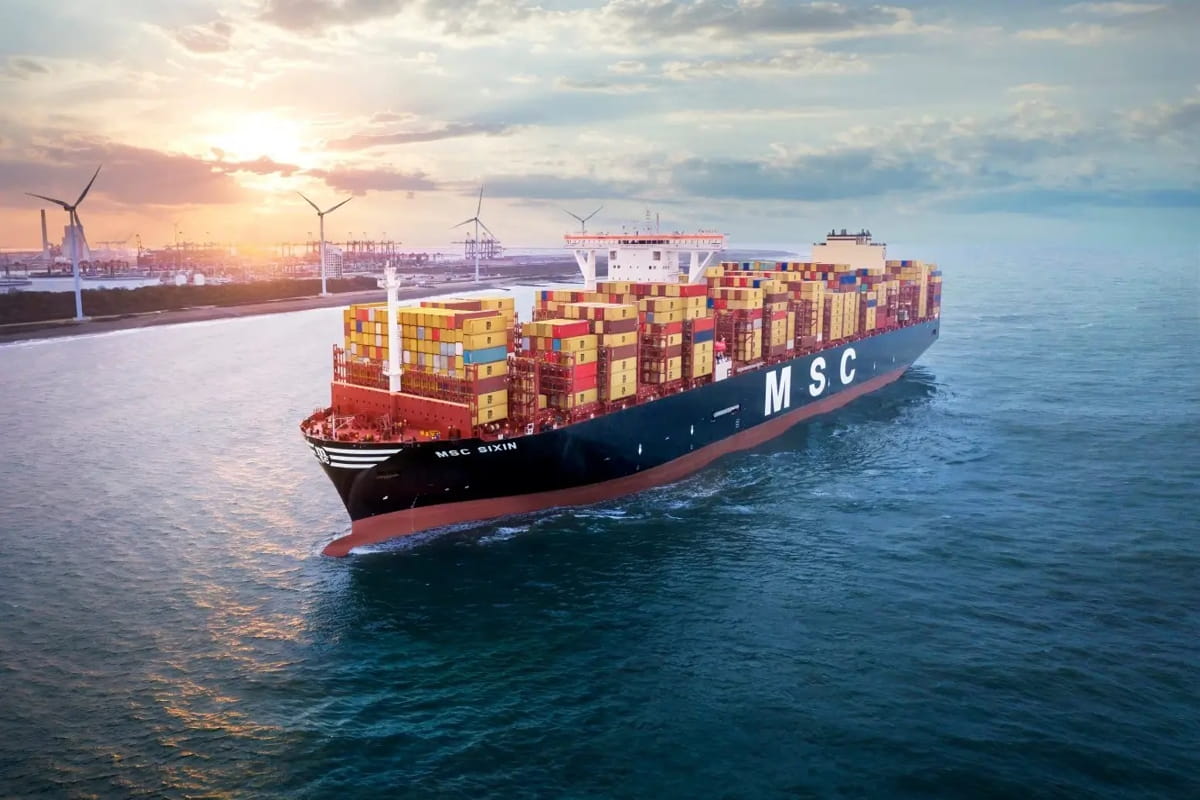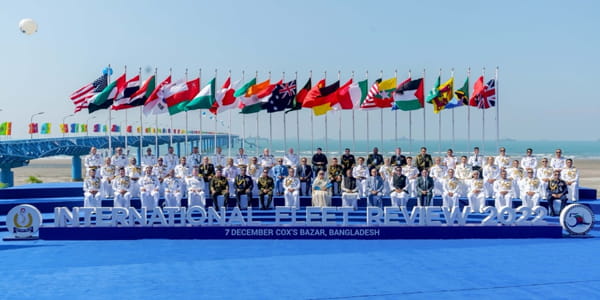
A cargo ship in the Indian Ocean. | India Shipping News
The Bay of Bengal countries have the potential to form a cohesive community that fosters economic cooperation, promotes peaceful connectivity, and addresses common challenges, charting a path toward prosperity and security for the region and beyond. However, only with an expanded configuration could it then embark on putting in place a regional governance framework for the Bay of Bengal microcosmic entity that could serve as a model for other regions.
Introduction
Our planet, Earth, is predominantly made up of oceans, with 71% of its surface covered in water. All oceans are integrally interlinked in our oceanic planet. What happens in one ocean can and often does impact other such water bodies. The Indian Ocean – the third-largest ocean in this configuration – by virtue of its geographical location is sometimes referred to as the “Great Middle Bay”. It has catapulted to become a dominant global geopolitical and economic force and arena for contestation in the 21st Century, with its geopolitical importance being dramatically increased by virtue of its increasing centrality in global trade, industry, labour, environment and security issues.
Colonization resulted in the European powers competing for access to resources and new domains as markets overseas, far from their own native shores, and conducting extensive trade with or economic exploitation of those regions mostly using the sea lanes. Their quest for extractable resources and markets was essentially enabled by sea power. The strategic significance for trade and military movement was further enhanced by maritime connectivity to distant regions.
Successive colonial powers such as the Portuguese, the Dutch, the French and the British used the sea lanes to foray into the Indian Ocean Region (IOR) to establish colonies in the 18th/19th Centuries. British colonial power asserted itself the most using this newfound sea power. By 1900 through their ability to dominate the sea lanes, Britain had turned the Indian Ocean “into a British Lake”. Today, over 90% of global trade by volume uses sea routes.
American Admiral Mahan strategically foresaw the importance of the oceans for nations when he famously enunciated:
“Letus not shrink from pitting a broad self-interest against the narrow self-interest to which some would restrict us …. Let us start with the fundamental truth, warranted by history, that the control of the seas, and especially along the great lines drawn by national interest or national commerce, is the chief among the merely material elements in the power and prosperity of nations. It is so because the sea is the world’s great medium of circulation …”
– Admiral Alfred Thayer Mahan, US Naval Historian and Strategist (Army & Navy Journal of London, January 1898)
Mahan’s logic was derived from his perception that Britain had wrested world power status in the 19th Century primarily by establishing dominance on or monopoly of the seas. Maritime commerce involved exchange of finished products for supplies and raw materials extracted, either by extortion or under agreement from the overseas domains (the basic tenet of colonialism). This could only be secured by ensuring command over the seas, whether in war or peace. He concluded that sea-borne commerce makes a nation great. From this hypothesis, Mahan forcefully advocated that the US should have a Navy second to none to acquire great power status.
Mahan’s strategic philosophy, at that time, was primarily for the Pacific and Atlantic Oceans and coal as the main energy source. However, the discovery of vast oil reservoirs in the Persian Gulf-Arabian Peninsula regions at the turn of 19th/early 20th Century gave increasing pre-eminence to oil over coal as fuel for industrial development and growth. The Indian Ocean inevitably catapulted to centre-stage in recent time, particularly after the opening of the Suez Canal and its command of the gateway to Persian Gulf hydrocarbon resources.
“It is only since the beginning of the 1970s that the Indian Ocean and its littoral states, which belong predominantly to the Third World, have begun to take on the characteristics of a major political region. The main factor contributing to this development was the assertive global strategy of the two superpowers (the United States and the Soviet Union) …. Conflicts with their origin outside the area (East-West and Sino-Soviet) …spread to the Indian Ocean Area. These outside influences, together with a growing number of conflicts between states within the region, point clearly to a need to seek and implement guidelines for limiting conflict and encouraging regional cooperation.”
– Dieter Braun in Preface to ‘The Indian Ocean – Region of Conflict or ‘Zone of Peace’?’ (1983) Wissenschaft Stiftung und Politik, Munich.
Applying the Mahan paradigm exponentially enhanced the importance of the Indian Ocean, progressively since the 1970s in the 20th Century and now well into the 21st Century.
The Indian Ocean: Relevance for Global Trade, Energy and Food Security
Over 90% of global trade uses sea routes, with over 80% of maritime oil trade passing through the Indian Ocean Region (IOR). Over 95% of China's trade with the Middle East, Africa and Europe transits the Indian Ocean, while India's maritime trade is over 70% by volume. The Indian Ocean also holds valuable resources such as fisheries and minerals. The Northern Indian Ocean is a crucial passageway for global east-west-east trade. Ensuring the uninterrupted flow of crude oil across the Indian Ocean and other oceanic regions is essential for major, middle and minor powers. However, the risk of strategic competition escalating into active contestation is a danger that all must avoid.
The states in the IOR hold more than 58% of the world's proven oil and over 46% of the world’s gas reserves. Globally, the Persian Gulf has emerged as the most important source of crude oil. The East African coast on the Indian Ocean also emerged as another major petroleum frontier. The seabed beneath the Timor Sea and the Bay of Bengal also contain substantial hydrocarbon (petroleum and gas) reserves. The competition between India and China over access to Myanmar’s offshore gas fields is partly attributable to the same compulsions.
The Northern Indian Ocean constitutes a key passageway in global east-west-east trade. Maintaining unimpeded flow of crude oil from producing to consuming countries in the IOR and across to other oceanic regions (through gateways/chokepoints) is a sine qua non for all major, middle or minor powers. Hence, the likelihood of strategic competition spiralling into active contestation is an underlying danger that all need to avoid. Singapore appears set to remain a strategic petroleum gateway between Indian and the Pacific Ocean to China, Japan and South Korea.
The Indian Ocean also contains non-energy renewable and non-renewable resources. Fisheries and minerals are the most commercially viable resources. Since more than a billion people globally rely on marine fish as their main source of protein, it adds strategic value to this oceanic region which hosts 45% of the world's fisheries and accounts for 20% of total global fish production.
However, there remain problems of overfishing, over exploitation and poaching in non-territorial waters or adjacent Exclusive Economic Zones (EEZ’s) that could result in over-exploitation and depletion of fish stock with serious implications for regional and global food security. The seabed also contain an abundance of golf/tennis ball-sized polymetallic nodules containing nickel, cobalt, iron, manganese and polymetallic massive sulphides that contain gold and greater copper, all of which exponentially increase the strategic value of these waters.
Bioprospecting for genetic resources may lead to new products and applications in medicine. Additionally, coastal sediments along many coastlines of this ocean contain titanium and zirconium (mainly off South Africa and Mozambique), tin placer deposits (off Myanmar, Thailand, and Indonesia) and zinc and copper ore in heavy mud in the Red Sea. The presence of numerous global powers – both extra-regional and regional – is testimony to the growing importance of the Indian Ocean over the last one hundred years.
The Political Economy of a Probable “Bay of Bengal Community"

The Indian Navy delegation participated in the maiden International Fleet Review hosted by Bangladesh, December 2022. | Ministry of Defence.
The Westphalian order led to European colonialism, while the fall of colonial powers after World War II marked the rise of new superpowers and the era of ‘neo-super colonialism’. Lesser powers must strategize for survival in a world dominated by global giants. Like the ‘divide-and-rule’ method of European colonial powers, neo-super colonists use similar tools to divide nations against each other in today's global power play.
The Bay of Bengal, an integral part of the Indian Ocean with a population of 1.7 billion and a GDP of USD 7 trillion, can form a ‘community’ of nations bridging together the South Asian Association for Regional Cooperation (SAARC) and the Association of Southeast Asian Nations (ASEAN) regions that would enhance overall cooperation.
Sub-regional cooperation within SAARC and the Indian Ocean Rim Association (IORA) could further contribute to regional cohesion. The region has a dispute-free maritime environment and fast-growing economies, and is a battleground for competing narratives from significant superpowers. Collaboration between these countries is crucial to address ecological threats and ensure a sustainable blue economy.
A cohesive community of Bay of Bengal littorals – initially through a Bay of Bengal Economic Cooperation – could potentially evolve into a Bay of Bengal Community unlocking limitless possibilities for prosperity. While a regional organization for cooperation, the Bay of Bengal Initiative for Multi-Sectoral Technical and Economic Cooperation (BIMSTEC) among Bay of Bengal countries has existed since 1997 and till date, it has no remarkable achievement to its credit.
The BIMSTEC’s nomenclature is a misnomer since some of the most important Bay of Bengal littoral states (namely Malaysia, Indonesia, and Singapore) are not members of it. Were the current BIMSTEC configuration to be expanded to make it truly an inclusive organization for all Bay of Bengal littorals, then one might reasonably expect a quantum leap forward in its ability to meaningfully address multi-sectoral issues effectively and to everyone’s benefit.
Conclusion
The Bay of Bengal countries have the potential to form a cohesive community that fosters economic cooperation, promotes peaceful connectivity, and addresses common challenges, charting a path toward prosperity and security for the region and beyond. However, only with an expanded configuration could it then embark on putting in place a regional governance framework for the Bay of Bengal microcosmic entity that could serve as a model for other regions.
(This is a modified version of the author’s article “Connectivity and Cooperation: The Bay of Bengal and Bangladesh in the Indian Ocean” published as a Working Paper by ISAS, National University of Singapore, on 3rd August 2023)